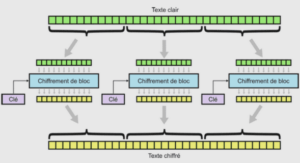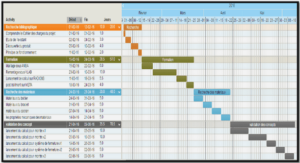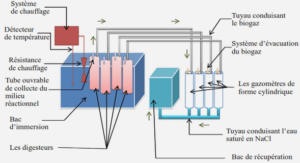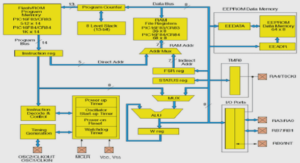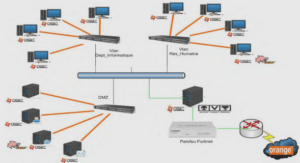Le modèle WSSUS
Dans un grand nombre de transmissions, les antennes d’émission et de réception ne sont pas en ligne de mire. Dans ce cas, le signal est réfléchi, diffracté ou diffusé par l’environnement de propagation, composé par des bâtiments, véhicules ou des obstacles naturels. Le signal émis passe alors par plusieurs trajets différents avant d’être reçu. Ce type d’environnement, appelé canal multi-trajet, est caractérisé par le nombre de trajets L, les retards τl et les gains hl,l = 0, 1, …, L − 1 des différents trajets qui le composent.
Réception d’un signal dans un SFN
Dans cette partie, on considère un récepteur mobile Rx se situant dans la zone de recouvrement entre deux cellules d’un réseau SFN (pour Single Frequency Network, en anglais), comme l’illustre la figure r.14 (a). Dans ce type de réseau, le signal est émis à la même fréquence quelle que soit l’antenne d’émission Tx. Suivant ce modèle, les évanouissements fréquentiels du canal peuvent affecter toute la bande passante d’un signal donné. Dans ce cas, la diversité fréquentielle de l’OFDM devient inutile, même si un codage canal est utilisé. Du point de vue du récepteur dans la zone de recouvrement, la réponse fréquentielle du canal est la somme des contributions du signal provenant de Tx1 et Tx2.
Deterministic Model
A simple method to determine the channel profile is to measure its impulse response at different points on a given area [54], [55]. This method leads to an empirical model of the channel. It is usually used in the planning of a network, in order to optimize the ratio between the installations cost and the size of the covered area. However, it requires a laborious measures campaign. Furthermore, this method does not specify the characteristic of the channel, as the number of paths, the delays etc. With the improvement of the computation capacity of the computers, the ray tracing technique has been developed, as depicted in [56], [57]. The method is based on the same principle as the geometrical optics, considering the light waves as rays following geometrical propagations. In this case, the electromagnetic waves of the signal is seen as a ray having linear propagation in a known environment (thanks to a map, a building plan etc.). It is then possible to determine the signal trajectories. This method gives a better description of the physical reality of the channel than the empirical model, but requires a greater computational complexity. These two methods are very useful to plan a network and to provide an a priori state of the propagation channel for the user in a given environment. However, it is sensitive to the random variation of the channel.
Principle of the Method
In most of transmission models, the receiver does not have any knowledge of the CSI nor of the statistics of the channel. This is particularly the case in broadcast systems. In the LMMSE techniques described in the literature, the covariance matrix RH is considered to be known, or must be estimated. Thus, this matrix must be regularly updated in order to track the channel variations. The solution proposed in this chapter and described in Figs. 3.1 and 3.2 avoids the a priori knowledge of RH. To this end, an artificial signal (composed of pilots only) is transmitted through a filter G and added to the received signal. Actually, the filter G plays the role of an artificial channel, whose parameters (coefficients, paths delays etc.) are perfectly known and tunable by the receiver. The statistics of the filter G is chosen in order to match a WSSUS channel. The coefficients of the filter G are randomly varying like an artificial channel. Consequently, we use a channel terminology to describe G. To do so, we note gn(τ ) and Gm,n the impulse response and the samples of the frequency response of the artificial channel, respectively
Discussion on the Choice of the Number of Paths of the Artificial Channel
In this section, the effect of the number of paths D of the artificial channel is studied,assuming that the parameters βmax and Γd(β) are chosen according to the previous recommendations. By hypothesis, the number of paths L of the physical channel is unknown, thus,LK is also unknown in (3.6). The LMMSE estimation of the hybrid channel K is then performed by means of the covariance matrix RG defined by (3.12). Recalling that LK ≤ L + D,the larger D compared to L, the less the error between D and LK. The physical consequence is that the gain of the channel becomes negligible in comparison to the one of the added filter, which justifies the masking effect. On one hand, the channel is characterized by the non-null eigenvalues of its covariance matrix [114]. On the other hand, as the channel covariance matrices are Hermitian, comparing the eigenvalues of two covariance matrices is equivalent to comparing the matrices themselves [115]. In order to justify the approximation RK ≈ RG, the eigenvalues of the matrices RK and RG are compared. For m = 0, …, M − 1 we define λ(K)m and λ(G)m the eigenvalues of RK and RG respectively
Mean Square Error of ACA-LMMSE
The performance of the ACA-LMMSE estimator is first evaluated by means of the minimum means square error MMSE, estimated by the value E{1MPM−1m=0 |Hm − Hˆm|2}. The simulations parameters remain the same as in the previous section. Two pilot distributions are considered: a preamble scheme (noted PB), according to the analytical developments given in this chapter, and a distribution in staggered row (noted SP), according to the DRM standard. In Figs. 3.7 and 3.8, the ACA-LMMSE estimator is compared with the usual LMMSE and LS ones. In the SP case, LS is combined with the polynomial interpolation in order to get the estimation over the entire time and frequency lattice. According to robustness C (see [1],Appendix L), the pilot tones are placed every 4 carriers along the frequency axis and 1 pilot every 2 carriers along the time axis. The filter G has the following parameters: D = 15,τ(G) max = TCP = 5.33 ms and the delay profile follows a decreasing exponential profile. This configuration is coherent regarding the previous requirements. For both PB and SP cases and whatever the SNR, the MMSE of the ACA-LMMSE estimator reaches a value 2 dB higher than the theoretical LMMSE. The ACA-LMMSE performance is slightly degraded compared to LMMSE, as the proposed estimator uses the covariance matrix RG which is naturally different from RH. This phenomenon can be explained by comparing the theoretical expressions of the MMSE of the usual LMMSE (2.26) and ACA-LMMSE (3.10). Indeed, MMSE is a growing function with respect to the value L (or LK in (3.10)). Yet, LK is set in order to get LK ≥ L, so MMSEACA ≥ MMSELMMSE. Now comparing ACA-LMMSE with LS, it clearly outperforms LS as it offers an MMSE gain around 10 dB. This result is valid for both SP and PB distributions. Note then that the differences between the SP and PB cases are due to the interpolation technique that inevitably degrades the estimation quality.
SNR Estimation: State of the Art
The SNR estimation methods are all based on the same elementary scheme:
1. The noise variance estimation ˆσ2 is first performed,
2. An estimation of the transmitted signal power Pˆs is achieved,
3. The SNR, noted ρ is finally obtained by ˆρ = Pˆs/σˆ2.
Alternatively, the steps 2. and 3. are sometimes replaced by the following processing:
2. The second order-moment of the received signal is estimated Mˆ2 = Pˆs + ˆσ2,
3. the SNR is estimated by ˆρ = Mˆ2/σˆ2 − 1.
The main difference between the techniques of the literature lies in the way to estimate σ2. A wide range of usual methods are described in [123–125]. Among them, the secondand forth-order moment (M2M4) estimator, is firstly mentioned in [126]. Its principle is to estimate the second order moment of the received signal Um M2 = E{UmU∗m} = Ps + σ2 on one hand, and the forth order moment M4 = E{(UmU∗m)2} = P2s + 4Psσ2 + 2σ4 on the other hand.
Spectrum Sensing
Wireless communications in general are facing a constant increase of data rate-consuming transmissions, due to the multiplications of the applications and services, while the usable spectrum is naturally limited. Furthermore, most of the bands are already allocated to specific licenses. However, some of these licensed bands are not used at full capacity, which results in spectrum holes along the time and frequency axes [130], whereas they could be exploited in order to achieve the requirements of data rate. Away from the usual paradigm in which the channels are allocated only for licensed users, Joseph Mitola defines the cognitive radio [131], allowing an opportunistic access by unlicensed users to the unused frequency bands. In such a network, the opportunistic users, called secondary users (SUs) can use licensed bands when primary users (PUs) are absent from those ones. The main condition for the SUs to use the licensed bands is to minimize the interferences with PUs. Thus, they must be able to sense the presence of the PUs, even if the PU’s signal is attenuated compared to the noise level. Fig. 4.18 depicts the concept of spectrum sensing: A PU transmitter (PU-Tx) is transmitting to a PU receiver (PU-Rx) while a SU transmitter intends to transmit in the same band. In order to avoid the interferences with the PU, the SU has to perform spectrum sensing. In order to lighten the drawing, only one PU-Rx and two SU-Rx are depicted, but the network can obviously be more complex.
Effect on the Choice of eσ on the Detector Performance
It is shown in this section that the choice of the threshold eσ value does not have any effect on the detection performance of the proposed method, but only plays a role on the speed of convergence of the algorithm. Fig. 4.22 depicts the curves of probabilities of detection Pd and false alarm Pfa versus the SNR from -15 dB to 10 dB. In order to ensure the convergence of the algorithm, eσ must have a low value. Subfigures (a) and (b) then depict the curves Pd and Pfa for eσ = 0.01 and eσ = 0.0001 respectively. According to these recommendations, the initialization σ2 (i=0) is equal to 40 × M2. We also arbitrary fix the threshold ς = 0.01, its effect on the detection performance being further studied. The figure is obtained thanks to 2000 simulation runs.
Polarization Diversity
In the environments or standards in which the spatial diversity is unsuitable, it is possible to implement the polarization diversity, based on the polarization of the electrical field. To this end, the mobile station is composed of two antennas in the same plane but whose directions differ with regard to the ground. The principle of this diversity is presented in [164] in a simple case, in which the signal is considered in an azimuth plane that is orthogonal to the plane of the antennas. A generalized model is provided in [157], and described in Fig. 6.7. In this model, we suppose that the arrival directions of the different signal components are not restricted to the azimuth plane. Let us define Ex and Ey the components of the electrical field.
Bit Error Rate Performance
We now characterize the performance of the global system, including channel encoding and channel estimation. We use a Reed-Solomon code with rate 1/2. A least square (LS) estimation is performed on the pilot tones, and a cubic spline interpolation allows to get the channel estimation on all the bandwidth. The observation duration is almost equal to 10TC for both processes, which allows to get a sufficient statistic to draw conclusions..
|
Table des matières
Introduction
r.1 Contexte et modèle
r.1.1 Le canal de transmission multi-trajet
r.1.2 Transmission d’un signal OFDM
r.2 Techniques d’estimation : état de l’art
r.2.1 Les pilotes
r.2.2 Les critères LS et MMSE
r.2.3 Techniques d’interpolation
r.2.4 Autres méthodes d’estimation de canal
r.3 Estimation ACA-LMMSE
r.3.1 Principe du ACA-LMMSE
r.3.2 Complexité de ACA-LMMSE
r.3.3 Choix des paramètres de G
r.3.4 Résultats de simulations
r.3.5 Conclusion et perspectives
r.4 Estimation conjointe du RSB et du canal
r.4.1 Présentation de l’algorithme
r.4.2 Convergence de l’algorithme
r.4.3 Résultats de simulations
r.4.4 Conclusion et perspectives
r.5 Étude des interpolations sur les performances de l’estimation d’un canal de Rayleigh
r.5.1 Modèle
r.5.2 Statistique des erreurs d’interpolation
r.5.3 Considérations géométriques
r.5.4 Résultats de simulations
r.5.5 Conclusion et perspectives
r.6 Application de la diversité de délai cyclique à un SFN
r.6.1 Modèle
r.6.2 Diversité de délai cyclique
r.6.3 Résultat de simulation
Conclusion
Abstract
Introduction
1 System, Models, Basic Elements
1.1 Introduction
1.2 The Transmission Channel
1.2.1 The Multipath Channel
1.2.2 Channel Models
1.2.3 Channel Statistics
1.3 The OFDM Signal and the Transmission Chain
1.3.1 History
1.3.2 Modelisation of the OFDM Signal
1.3.3 Transmission of the OFDM Signal
1.3.4 Discrete Model of the OFDM Transmission
1.3.5 Frequency Covariance and Correlation Matrix
1.4 Simulation of the Transmission Channel
1.5 Conclusion
2 Channel Estimation Methods
2.1 Introduction
2.1.1 Time or Frequency Domain Estimation
2.1.2 Blind Estimation
2.1.3 Transmission Methods with a Known Channel State Information
2.1.4 Semi-blind Estimation
2.2 The Pilots in the OFDM Frame
2.3 LS and MMSE Criteria
2.3.1 Principle of LS Estimation
2.3.2 Principle of Linear-MMSE Estimation
2.4 Pilot-Aided Estimation Methods
2.4.1 Methods with Knowledge of Some Properties of the Channel
2.4.2 Methods without Knowledge of the Channel Properties
2.4.3 Iterative and Recursive Channel Estimation
2.5 Conclusion
3 Artificial Channel Aided-LMMSE Channel Estimation
3.1 Introduction
3.2 Description of the Method
3.2.1 Principle of the Method
3.2.2 ACA-LMMSE channel Estimation
3.2.3 Characteristics of ACA-LMMSE
3.2.4 Complexity Comparison with Standard LMMSE
3.3 Choice of Filter G Parameters
3.3.1 Discussion on the Choice of the Parameters
3.3.2 Discussion on the Choice of the Maximum Delay τ(G) max
3.3.3 Discussion on the Choice of the Number of Paths of the Artificial Channel
3.3.4 Discussion on the Choice of the Multipath Intensity Profile
3.4 Simulations Results
3.4.1 Mean Square Error of ACA-LMMSE
3.4.2 Comparison with other methods
3.4.3 Suitability of ACA-LMMSE in general WSSUS Channel Models
3.4.4 Reduction of Implementation Complexity
3.5 Application to Intersymbol Interference Cancellation
3.5.1 Model of ISI Channel
3.5.2 RISIC Algorithm
3.5.3 ACA-LMMSE with RISIC Algorithm
3.5.4 Simulations Results for RISIC combined with ACA-LMMSE
3.6 Conclusion
4 MMSE-based Joint Iterative SNR and Channel Estimation
4.1 Introduction
4.2 SNR Estimation : State of the Art
4.3 First Approach of the Method in a Simple Context
4.3.1 System Model
4.3.2 Proposed Algorithm – Theoretical Case
4.3.3 Simulations Results – Theoretical Approach
4.4 Realistic Approach of the Joint estimation
4.4.1 Proposed Algorithm – Realistic Case
4.4.2 Convergence of the Algorithm
4.4.3 Simulations Results – Realistic Approach
4.5 Application of the Algorithm to Spectrum Sensing
4.5.1 Spectrum Sensing
4.5.2 Proposed Detector
4.5.3 Analytical Expressions of the Detection and False Alarm Probabilities
4.5.4 Simulations Results
4.6 Conclusion
5 Study of the Interpolation on the Rayleigh Channel Estimation Performance
5.1 Introduction
5.2 System Model
5.3 Statistics of the Interpolation Errors
5.3.1 Nearest Neighbor Interpolation
5.3.2 Linear Interpolation
5.3.3 Statistics of the Interpolated Noise
5.4 Mean Square Error of the Estimations Performed with Interpolation
5.5 Geometrical Considerations
5.5.1 System Model
5.5.2 BPSK Constellation
5.5.3 4-QAM Constellation
5.5.4 Analytical Expression of the BER Floor
5.6 Simulation Results
5.6.1 Simulations Parameters
5.6.2 Analytical BER Floor
5.7 Conclusion
6 Application of Cyclic Delay Diversity to a Single Frequency Network
6.1 Introduction
6.2 Different Kinds of Diversity
6.2.1 Time Diversity
6.2.2 Spatial Diversity
6.2.3 Polarization Diversity
6.2.4 Frequency Diversity
6.3 Application of the Cyclic Delay Diversity in a SFN
6.3.1 Model Description
6.3.2 Simulation Parameters
6.4 Cyclic Delay Diversity
6.4.1 Principle of CDD
6.4.2 Generalization to a Multitransmitter Network
6.5 Simulations Results
6.5.1 Realistic DRM+ Cell
6.5.2 Measurement of the Fading
6.5.3 Bit Error Rate Performance
6.6 Conclusion
General Conclusion
A Appendix of the Chapter 1
A.1 Expression of the Channel Covariance
A.2 Proof of the Diagonalization of a Circulant Matrix in the Fourier Basis
B Appendix of the Chapter 4
B.1 Proof of the Convergence to Zero of the Algorithm when Using the Matrix LSH
B.2 Proof of the Convergence to Zero of the Algorithm under the Hypothesis H0
C Appendix of the Chapter 5
C.1 Error of the Linear Interpolation
List of Figures
List of Tables
List of Algorithms
![]() Télécharger le rapport complet
Télécharger le rapport complet

